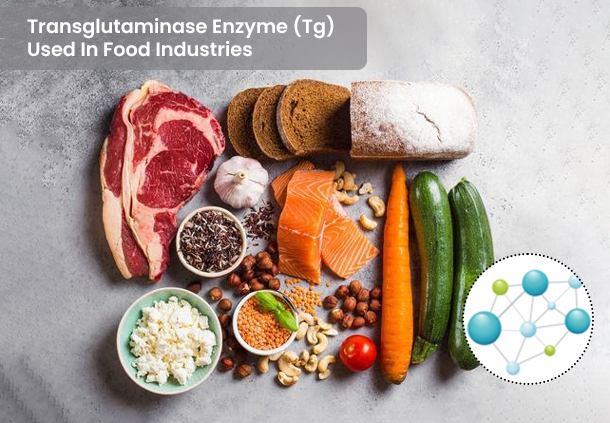Transglutaminase Enzyme Used (Tg) In Food Industries


Before learning about Transglutaminase (TG) Enzymes, let’s start with a simple fact: food trends change all the time! Some ingredients become popular, while others raise questions. New foods are discovered, and old ones are used in new ways. TG enzyme is one of those ingredients, so let’s dig in and learn more
What is Transglutaminase Enzyme?
Transglutaminase, usually referred to as TG in simplified notation, is a common enzyme that can be found in people, animals, plants, and microorganisms. Our bodies use transglutaminase tg to aid with nutrition, digestion, muscle growth, and the removal of pollutants. This enzyme is extensively spread throughout the globe and is collected through molecules of basic amino acids.
How Does Transglutaminase Enzyme Function?
In liquid proteins, transglutaminase function stimulates the cross-linking of the side molecules of two amino acids, glutamine and lysine. In the process of creating protein bonding, transglutaminase TG unites the different types of meat. This results in the establishment of iso-peptide bonding amongst proteins and the releasing of the -(glutamyl)-lysine chain. Physical strain and heat processing doesn’t break this connection. Transglutaminase functions as a catalyst to aid in the unaltered binding of dietary proteins. It is employed to increase food items’ stickiness, stiffness, flexibility, and ability to bind fluid. As a result, the food products’ aroma and consistency are strengthened. The industrial manufacture of numerous food products makes use of Transglutaminase’s bridge ability. Among these are the production of baked items, cheese, and other milk products.
What Are Transglutaminase Enzyme’s Used?
Enzymes are the hidden kitchen wizards, working behind the scenes to add flavor, color, and texture to our favorite foods. They help cheese come to life, beer bubbles just right, bread rises to perfection, and even makes fruit juice smooth and refreshing. From kneading to brewing, enzymes make every bite and sip a little more magical.
Transglutaminase (TG) enzyme acts like a food glue, helping proteins stick together in the right way. It changes the structure of proteins to improve texture, make food smoother, and help it hold moisture. This process keeps important nutrients like lysine locked in, so the food stays tasty and nutritious. Simply put, TG enzyme helps make food better and more enjoyable
Moreover, other functions of transglutaminase comprise as below:
- Uniformizing the size of the meat, chicken, and seafood for safe and consistent cooking.
- Increasing the taste, smoothness, and presentation of meals while minimizing food waste. As a result, there are significant financial benefits and fewer negative ecological effects.
- Transglutaminase enzyme helps make yogurt smoother and last longer by balancing the milk’s acidity. It also makes ice cream creamier by improving its texture during production
- combining sausages, chicken, and seafood
- Generating inventive food mashups (like beef and bacon); & Using foodstuff to create unique impacts
- Transglutaminase enzyme helps create fancy and flavorful dishes, like shrimp pasta and meaty noodles, by blending plant and animal proteins. It makes every bite delicious, smooth, and packed with goodness!
Is Transglutaminase (TG) Enzymes Safe?
Absolutely! The U.S. Food and Drug Administration (FDA) has given Transglutaminase (TG) enzyme a big thumbs up by labeling it GRAS (Generally Recognized as Safe) for over a decade. That means it’s been checked, approved, and good to go for safe use in food
In order to meet the demands of our expanding civilization, TG has so far shown to be a secure way to combine food items. Transglutaminase (TG) enzyme is not a troublemaker it doesn’t make meat unsafe or affect food allergies. And here’s the best part: when food is cooked properly, TG enzyme waves goodbye and disappears! So, it’s all about safe, tasty, and well-cooked meals
How Do You Get Transglutaminase (Tg)?
Transglutaminase (TG) enzyme is a natural team player, found in both plant and animal foods. But here’s the cool part—it can also be made meat-free and vegan-friendly by using a special fermentation process with the helpful bacteria Streptoverticillium mobaraense. That means TG enzyme can work its magic in all kinds of foods, no matter the diet.
Conclusion:
The usage of TG is secure when done correctly. The study of transglutaminase’s impacts on celiac disease is still being conducted. Since TG was first added to our food production more than 20 years ago, there haven’t been any recognised problems with food security, or scientifically determining population health. So, if Transglutaminase in food is still causing you anxiety, reviewing the ingredient declaration will make it clear what it is. Meanwhile, we should have the knowledge and capacity as consumers to make intelligent food decisions.
Through enhanced technology and modern labs, Ultrez Enzymes with its team of experts makes sure to offer quality products. The in-house products go through precise quality check procedures to attain the best industry standards.
Looking for a pioneer in enzyme manufacturing and distributing? Connect with us.

